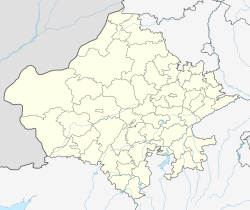Khatushyam Ji | |
|---|---|
| Khatoo | |
 Entrance gate of Khatoo | |
| Coordinates: 27°21′50″N75°24′09″E / 27.363954°N 75.402557°E | |
| Country | |
| State | Rajasthan |
| District | Sikar |
| Government | |
| • Type | Nagar Palika Khatu |
| • Body | Sikar-Khatoo Nagar Palika |
| Languages | |
| • Official | Hindi |
| Time zone | UTC+5:30 (IST) |
| ISO 3166 code | RJ-IN |
| Vehicle registration | RJ- |
Khatoo or Khatu, also known as Khatushyam Ji, is a town of religious importance located in the Sikar district of the Indian state of Rajasthan. It is approximately 43 km from Sikar city and 17 km from Reengus town. Situated in the Dhundhar region, Khatoo is known for the Khatu Shyam Temple, one of Rajasthan’s most sacred Hindu pilgrimage sites. [1]

